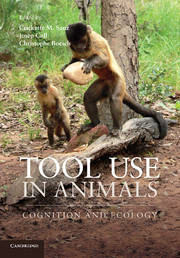Book contents
- Frontmatter
- Contents
- List of contributors
- Part I Cognition of tool use
- Part II Comparative cognition
- Part III Ecology and culture
- Part IV Archaeological perspectives
- 11 From pounding to knapping: How chimpanzees can help us to model hominin lithics
- 12 Early hominin social learning strategies underlying the use and production of bone and stone tools
- 13 Perspectives on stone tools and cognition in the early Paleolithic record
- Index
- References
13 - Perspectives on stone tools and cognition in the early Paleolithic record
from Part IV - Archaeological perspectives
Published online by Cambridge University Press: 05 March 2013
- Frontmatter
- Contents
- List of contributors
- Part I Cognition of tool use
- Part II Comparative cognition
- Part III Ecology and culture
- Part IV Archaeological perspectives
- 11 From pounding to knapping: How chimpanzees can help us to model hominin lithics
- 12 Early hominin social learning strategies underlying the use and production of bone and stone tools
- 13 Perspectives on stone tools and cognition in the early Paleolithic record
- Index
- References
Summary
Introduction
Cognitive archaeology is an unsettling area of study for many archaeologists, and it is unsurprising given the incredible challenges in taking the static remains of past people, most of them from a species separate from our own, and saying something about the processes of the mind that led to those remains. The attraction, however, remains great. As the chapters of this volume show, similarly challenging questions are being asked especially of extant primates, but also interestingly a variety of other living species, with experiments and field observations cleverly designed to probe into what these animals know about what they are doing. Archaeology has the potential to provide some insights into the evolutionary context of the modern cognitive condition, certainly for hominins who for 2.6 million years have left behind a record of their tool use, but also perhaps in a more limited fashion for non-human primates (Haslam et al., 2009).
Of course, the modern human cognitive condition is easily experienced but very difficult to conceptualize, and these difficulties carry over into cognitive archaeology. Wynn (2009), while noting that the field is characterized by a diverse set of theoretical underpinnings, argues that evolutionary cognitive archaeology has been approached from three principle perspectives: the relationship between language and the mind; the relationship between the organization and context of actions and the mind; and representational theories of the mind based on cognitive psychology and neurosciences that look at how the brain actually works. If we ignore the methodological and theoretical debates within the cognitive sciences, as well as issues of communication between two different fields (i.e., archaeology and cognitive sciences), there are still significant hurdles. How does archaeology, a field that depends heavily on theoretical contributions from other fields, operationalize theoretical approaches in testable ways? This is especially the case for the Plio-Pleistocene archaeological record, which is limited in scope and dramatically different from data sets produced in the cognitive sciences. As part of this operationalization, often cognitive approaches to the archaeological record risk not adequately taking into consideration some of the unique properties of this record and especially of stone tools.
- Type
- Chapter
- Information
- Tool Use in AnimalsCognition and Ecology, pp. 286 - 309Publisher: Cambridge University PressPrint publication year: 2013
References
- 9
- Cited by

